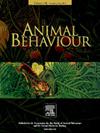本土两栖蝌蚪对外来入侵非洲爪蛙的反捕食反应
IF 2.3
2区 生物学
Q2 BEHAVIORAL SCIENCES
引用次数: 0
摘要
生物入侵是全球环境变化的主要驱动力。外来入侵物种可以影响生态系统动态,包括种间关系,如竞争和捕食。尽管人们普遍认识到,入侵性捕食者对本地猎物的影响仍然很少有文献记载,特别是在两栖动物中。非洲爪蛙(Xenopus laevis)原产于南非,在法国西部成功地建立了种群,并在最近几十年扩大了其活动范围。众所周知,非洲爪蛙捕食本地两栖动物;然而,捕食风险的间接影响仍然未知。利用10分钟的录像,测试了法国湿地常见的一种本地蛙类Pelophylax spp.蝌蚪是否对入侵的非洲爪蛙表现出抗捕食反应。这些反应与其他捕食者的反应进行了比较,包括本地蛙类幼虫和外来红色沼泽小龙虾克氏原螯虾。本地蝌蚪与捕食者的距离最大,与其他捕食者相比,当它们暴露于非洲爪蛙时,它们更聚集(与更小的最近邻居距离)。然而,个体花在游泳和探索上的时间以及在探索过程中的平均速度在掠食者之间没有差异。本研究重点研究了本土蝌蚪对入侵捕食者的识别和响应能力,强调了本土种群面临的生态挑战。本文章由计算机程序翻译,如有差异,请以英文原文为准。
Antipredator responses of native amphibian tadpoles to the presence of invasive alien African clawed frogs
Biological invasions are a primary driver of global environmental changes. Invasive alien species can affect ecosystem dynamics, including interspecific relationships such as competition and predation. Although widely recognized, the impacts of invasive predators on native prey remain sparsely documented, particularly in amphibians. African clawed frog, Xenopus laevis, which is native to South Africa, has successfully established populations in western France and has expanded its range in recent decades. African clawed frog is known to prey on native amphibians; however, the indirect effects of predation risk remain unknown. Using 10 min video recordings, whether Pelophylax spp. tadpoles, which is a native frog common in French wetlands, showed antipredator responses to the invasive African clawed frog was tested. These responses were compared with those to other predators, including native Odonata larvae and alien red swamp crayfish, Procambarus clarkii. Native tadpoles displayed the greatest distance from the predator, and they were more aggregated (with a smaller nearest neighbour distance) when exposed to African clawed frogs compared with other predators. However, the time individuals spent swimming and exploring as well as the average speed during exploration did not differ among predators. This study focuses on the ability of native tadpoles to recognize and respond to invasive predators, emphasizing the ecological challenges faced by native populations.
求助全文
通过发布文献求助,成功后即可免费获取论文全文。
去求助
来源期刊

Animal Behaviour
生物-动物学
CiteScore
4.60
自引率
8.00%
发文量
236
审稿时长
10.2 weeks
期刊介绍:
Growing interest in behavioural biology and the international reputation of Animal Behaviour prompted an expansion to monthly publication in 1989. Animal Behaviour continues to be the journal of choice for biologists, ethologists, psychologists, physiologists, and veterinarians with an interest in the subject.
 求助内容:
求助内容: 应助结果提醒方式:
应助结果提醒方式:


